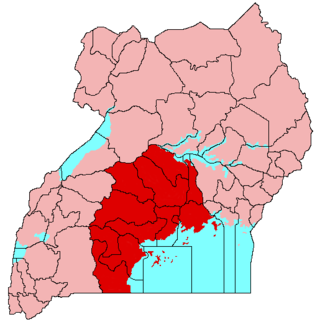
Buganda is a Bantu kingdom within Uganda. The kingdom of the Baganda people, Buganda is the largest of the traditional kingdoms in present-day East Africa, consisting of Uganda's Central Region, including the Ugandan capital Kampala. The 14 million Baganda make up the largest Ugandan region, representing approximately 16% of Uganda's population.

Daudi Cwa II was the 34th Kabaka of the Kingdom of Buganda from 1897 until 1939.

Ronald Edward Frederick Kimera Muwenda Mutebi II is King of the Kingdom of Buganda. He is the 36th Kabaka of Buganda.

The Conservative Party (CP) is a centre-right political party in Uganda. It is led by Ken Lukyamuzi.

Kabaka is the title of the king of the Kingdom of Buganda. According to the traditions of the Baganda they are ruled by two kings, one spiritual and the other secular.
Chwa I Nabakka was Kabaka (King) of the Kingdom of Buganda. He reigned during the mid 14th century. He was the 2nd Kabaka of Buganda.
Kimera Walusimbi was Kabaka of the Kingdom of Buganda between 1374 and 1404. He was the third king of Buganda.
Rashid Kalema Muguluma was Kabaka of the Kingdom of Buganda, from 21 October 1888 until 5 October 1889. He was the 33rd Kabaka of Buganda.
Jjunju Sendegeya was Kabaka of the Kingdom of Buganda from 1780 until 1797. He was the twenty-sixth (26th) Kabaka of Buganda.
Mengo is a hill in Rubaga Division, Kampala, Uganda's capital and largest city. The name also applies to the neighborhood on that hill.
Ndawula Nsobya was Kabaka of the Kingdom of Buganda between 1724 and 1734. He was the 19th Kabaka or king of Buganda. He is remembered as a kind and gentle king.
Kamaanya Kadduwamala was Kabaka of the Kingdom of Buganda from 1814 until 1832. He was the twenty-eighth (28th) Kabaka of Buganda.

The Kasubi Tombs in Kampala, Uganda, is the site of the burial grounds for four kabakas and other members of the Baganda royal family. As a result, the site remains an important spiritual and political site for the Ganda people, as well as an important example of traditional architecture. It became a UNESCO World Heritage Site in December 2001, when it was described as "one of the most remarkable buildings using purely vegetal materials in the entire region of sub-Saharan Africa".

The Baganda also called Waganda, are a Bantu ethnic group native to Buganda, a subnational kingdom within Uganda. Traditionally composed of 52 clans, the Baganda are the largest people of the Bantu ethnic group in Uganda, comprising 16.5 percent of the population at the time of the 2014 census.
Charles Peter Mayiga is a Ugandan lawyer, cultural leader and author. He is the current katikkiro of Buganda, a constitutional monarchy in present-day Uganda. He was appointed to that position by the reigning Kabaka of Buganda, His Majesty Muwenda Mutebi II of Buganda, in May 2013, replacing engineer John Baptist Walusimbi.
Buganda Investments and Commercial Undertakings Limited(BICUL), is a holding company of the investment and business entities, owned by the Kingdom of Buganda, a constitutional monarchy in modern-day Uganda Kabaka of Buganda
Jehoash Ssibakyalyawo Mayanja Nkangi or Joash Mayanja Nkangi was a Ugandan lawyer, civil servant and politician. At the time of his death, he was the immediate past chairman of the Uganda Land Commission. He previously served as a cabinet minister in several ministries in the Cabinet of Uganda.
Michael Kintu was a Ugandan politician who served as Katikkiro of the Kingdom of Buganda from 1955 to 1964.

Butikkiro is the official residence for the Katikkiro of Buganda in Uganda.

An Engalabi, also known as an Engoma ensajja is a membranophone percussion instrument that is used in Central Africa especially in Uganda by tribes which include the Baganda, Banyankole, Buzimba, and Tagwenda. It is also known as omugalabi, engaija, egaabi, omugudu, omugwabe, long drum, Engaabe, emiidiri.








